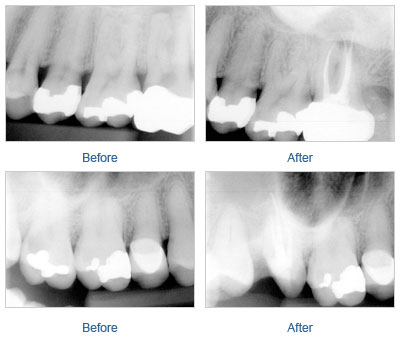Services
Endodontic
In a healthy vitalized tooth, entering the apex of the root are the blood vessels bringing nutrients that support any repairing function that the tooth needed and nerve bundle that provides the warning mechanism to protect the tooth i.e. too cold, too hot, too hard etcetera. Devitalization of a tooth describes a lost of nutrients and sensory support for the tooth.
This condition can be caused by many etiologies:
| 01. | Gross decay which encroaches on the pulp or nerve/blood vessels chamber. |
| 02. | Extensive history of restorations on the tooth can lead to devitalization. |
| 03. | History of traumatic injury to the tooth can lead to devitalization many years from the date of occurrence. |
| 04. | Some orthodontic movements can result in the devitalization of tooth. |
| 05. | Sudden traumatic injury that cause the exposure of nerve/blood vessels of the pulp chamber of the tooth. |
| 06. | Improper over brushing that cause severe abrasion which leads to devitalization. |
| 07. | Root exposures as a result of periodontal diseases. |
| 08. | Other rare oral pathologies can also lead to tooth devitalization. |
The process of devitalization in most cases will accompany by increasing level of pain and can reach excruciating level. However, some occurred without any symptoms and the only signs may be the gradual darker change in color of the tooth and or a small pimple on the gum of the affected tooth. Left alone tooth devitalization will lead to abscess around the root tip. This abscess will slowly destroy the surrounding bone of the root. When symptoms are sub clinical the only way to diagnose the problem is through periapical radiograph and pulpal test.
 Root Canal Therapy perform under strong anesthesia is virtually painless and in most cases provide immediate and long lasting relief from recurring pain. First the decay is removed and an opening into the pulp chamber is created. Using very special instruments the pulp including the nerve is removed. The abscess is reduced or removed and the canals are cleaned. Since the nerve and infection are gone you should have little further pain or discomfort. Depending on which technique best fit your needs the tooth may be left open to let the infection drain, medication may be temporarily placed to reduce some lingering infection or the pulp chamber may be permanently fill with an inert material, usually gutta percha. The tooth is then sealed to prevent bacteria from reentering the tooth. Because a root canal filled tooth becomes drier and brittle over time, a crown is recommended to cover the tooth to protect it from breaking. Root canal therapy has a high success rate, but occasionally a tooth must be retreated, surgically treated, or extracted if the infection can’t be brought under control. A tooth is a part of your body like your finger or toe or ear and should not be removed without careful thought and consideration. That is why we believe in saving teeth through RCT and extraction only as the last resource.
Root Canal Therapy perform under strong anesthesia is virtually painless and in most cases provide immediate and long lasting relief from recurring pain. First the decay is removed and an opening into the pulp chamber is created. Using very special instruments the pulp including the nerve is removed. The abscess is reduced or removed and the canals are cleaned. Since the nerve and infection are gone you should have little further pain or discomfort. Depending on which technique best fit your needs the tooth may be left open to let the infection drain, medication may be temporarily placed to reduce some lingering infection or the pulp chamber may be permanently fill with an inert material, usually gutta percha. The tooth is then sealed to prevent bacteria from reentering the tooth. Because a root canal filled tooth becomes drier and brittle over time, a crown is recommended to cover the tooth to protect it from breaking. Root canal therapy has a high success rate, but occasionally a tooth must be retreated, surgically treated, or extracted if the infection can’t be brought under control. A tooth is a part of your body like your finger or toe or ear and should not be removed without careful thought and consideration. That is why we believe in saving teeth through RCT and extraction only as the last resource.